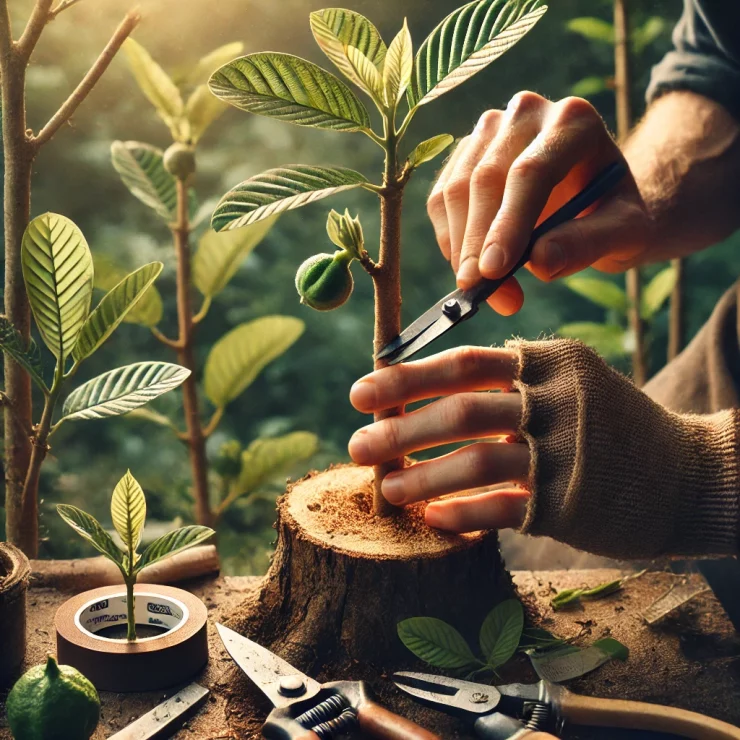Grafting is a horticultural technique that allows you to join two plants together so that they grow as one. This method is widely used to propagate fruit trees like apple and guava, enabling gardeners to produce more fruit, improve plant health, and even grow different varieties on the same tree. If you’re looking to boost your harvest and enjoy the fruits of your labor, here are some easy tips to graft apple and guava trees successfully.
Understanding Grafting
Before diving into the tips, it’s essential to understand the basic concepts of grafting. Grafting involves joining a scion (a young shoot or twig from a desired plant) to a rootstock (the base and roots of another plant). The scion and rootstock must be compatible and closely related, which is why grafting apple to apple or guava to guava is successful.
1.Choose the Right Time
Timing is crucial for successful grafting. The best time to graft apple and guava trees is during the late winter or early spring when the plants are still dormant. During this period, the sap is beginning to flow, which helps the graft heal and establish quickly. However, guava trees can also be grafted during the monsoon season, as the high humidity aids in the healing process.
2.Select Healthy Scions and Rootstock
For a successful graft, both the scion and rootstock need to be healthy. Choose a scion from a vigorous, disease-free tree with the desired fruit characteristics. The rootstock should also be healthy and robust, as it will provide the necessary nutrients and support for the grafted plant.
Apple Trees: Select scions from apple varieties known for their productivity and flavor. The rootstock should be hardy and well-adapted to your local climate and soil conditions.
Guava Trees: Choose scions from guava trees that produce high-quality, sweet fruits. The rootstock should be disease-resistant and capable of thriving in your area.
3.Use the Right Grafting Technique
There are several grafting techniques, but some are particularly well-suited for apple and guava trees:
Whip and Tongue Grafting (Apple): This method is ideal for apple trees because it provides a strong union and is relatively easy to perform. Cut both the scion and rootstock at an angle, then make a matching cut in the middle of each slant to form a “tongue.” Fit the scion and rootstock together, ensuring a tight union, and secure with grafting tape.
Cleft Grafting (Apple and Guava): Cleft grafting is useful when the scion is significantly smaller than the rootstock. Make a vertical cut in the rootstock and insert the scion into the cleft, ensuring that the cambium layers (the green layer just under the bark) of both parts align. Secure with grafting tape or wax.
Approach Grafting (Guava): This method is excellent for guava trees, especially when dealing with thin scions. Both the scion and rootstock are kept attached to their respective plants until the graft is successful. Make matching cuts on both and bind them together with grafting tape. After the graft has taken, sever the scion from its original plant.
4.Ensure Proper Alignment
The key to successful grafting is ensuring that the cambium layers of the scion and rootstock are aligned. The cambium is the active growing layer of the plant, and for the graft to heal and the two parts to grow together, these layers must be in contact. Even a slight misalignment can result in graft failure.
5.Secure the Graft
Once the scion and rootstock are joined, it’s essential to secure the graft to protect it while it heals. Use grafting tape, rubber bands, or grafting wax to hold the scion and rootstock together firmly. The tape or wax will also prevent the graft from drying out and protect it from pests and diseases.
6.Provide Aftercare
After grafting, the newly grafted plant needs proper care to ensure the graft heals and the plant thrives:
Watering: Keep the soil around the grafted plant moist but not waterlogged. Adequate moisture will support the healing process and encourage healthy growth.
Sunlight: Ensure the grafted plant receives plenty of sunlight, but avoid exposing it to intense heat immediately after grafting.
Pruning: Remove any shoots or suckers that emerge below the graft to prevent them from competing with the grafted scion for nutrients.
7.Monitor and Maintain
Keep a close eye on the grafted plant over the following weeks and months. Look for signs of new growth, which indicates that the graft is successful. If you notice any issues, such as the graft separating or signs of disease, address them promptly to give the graft the best chance of survival.
Grafting apple and guava trees is a rewarding way to increase your fruit harvest and explore new varieties in your garden. By following these easy tips, you can successfully graft these trees and enjoy the fruits of your labor for years to come. Whether you’re a seasoned gardener or a beginner, grafting is a valuable skill that can enhance your gardening experience and lead to bountiful harvests.






Add comment